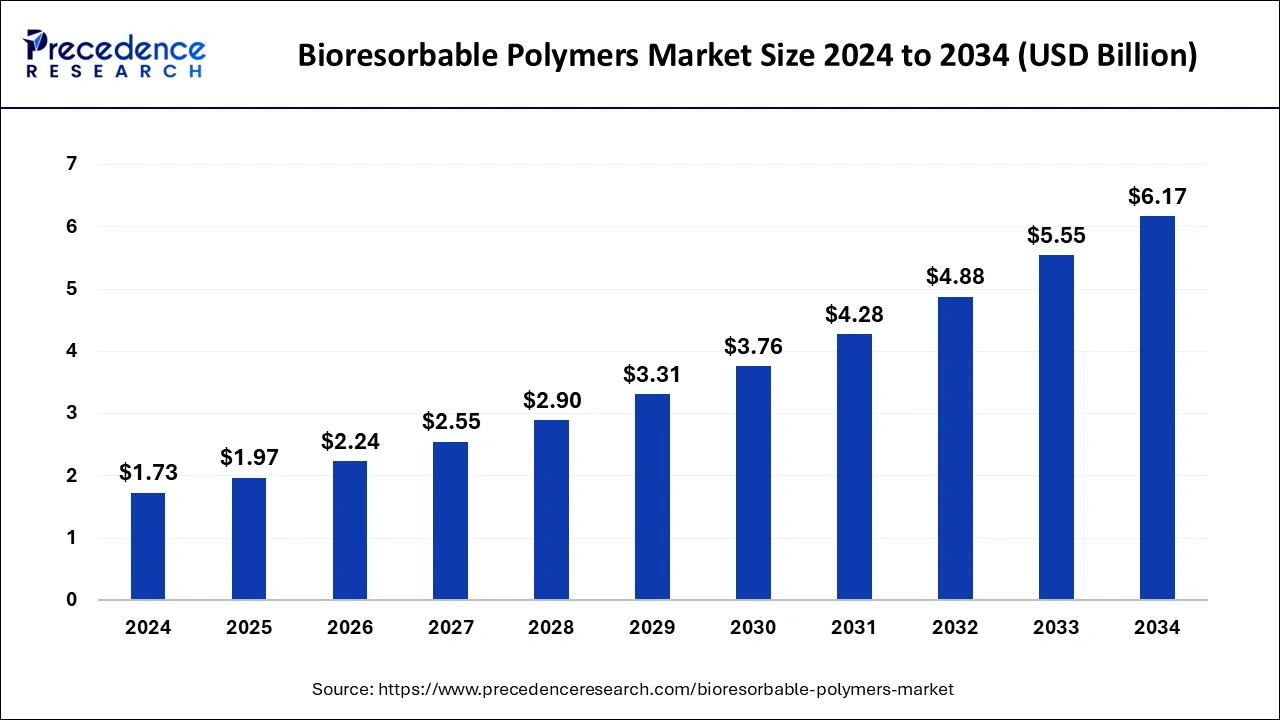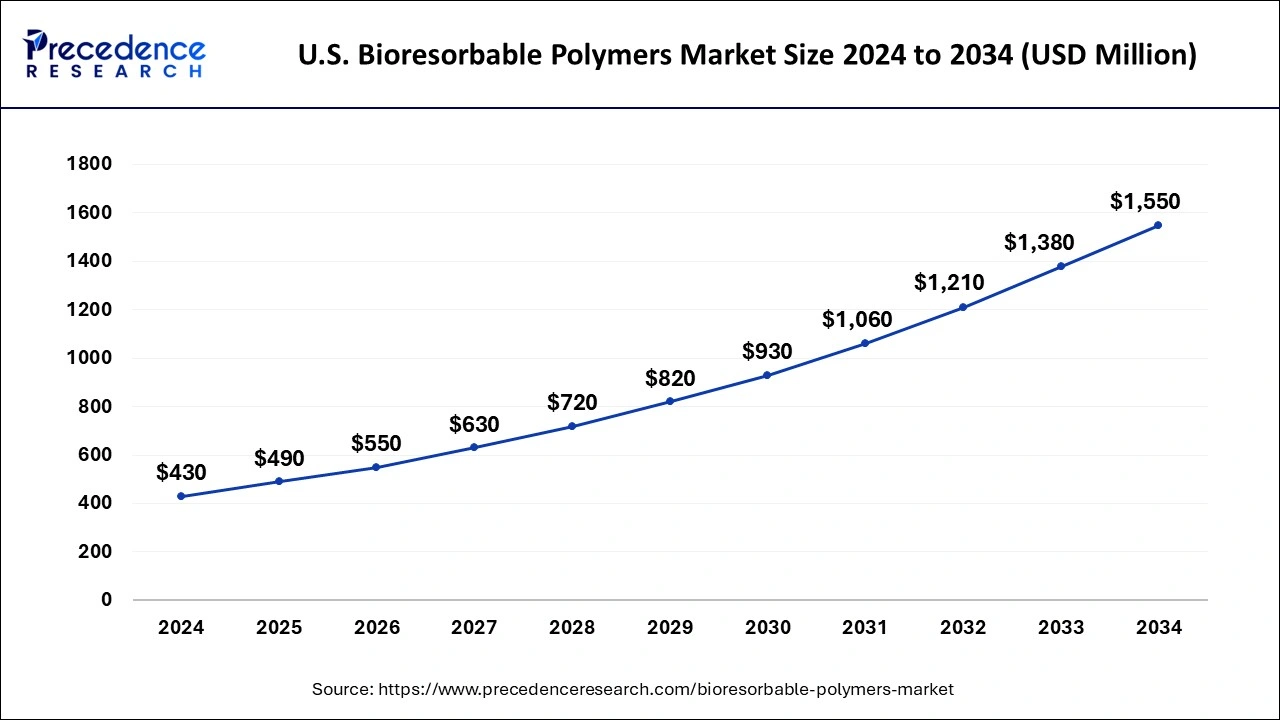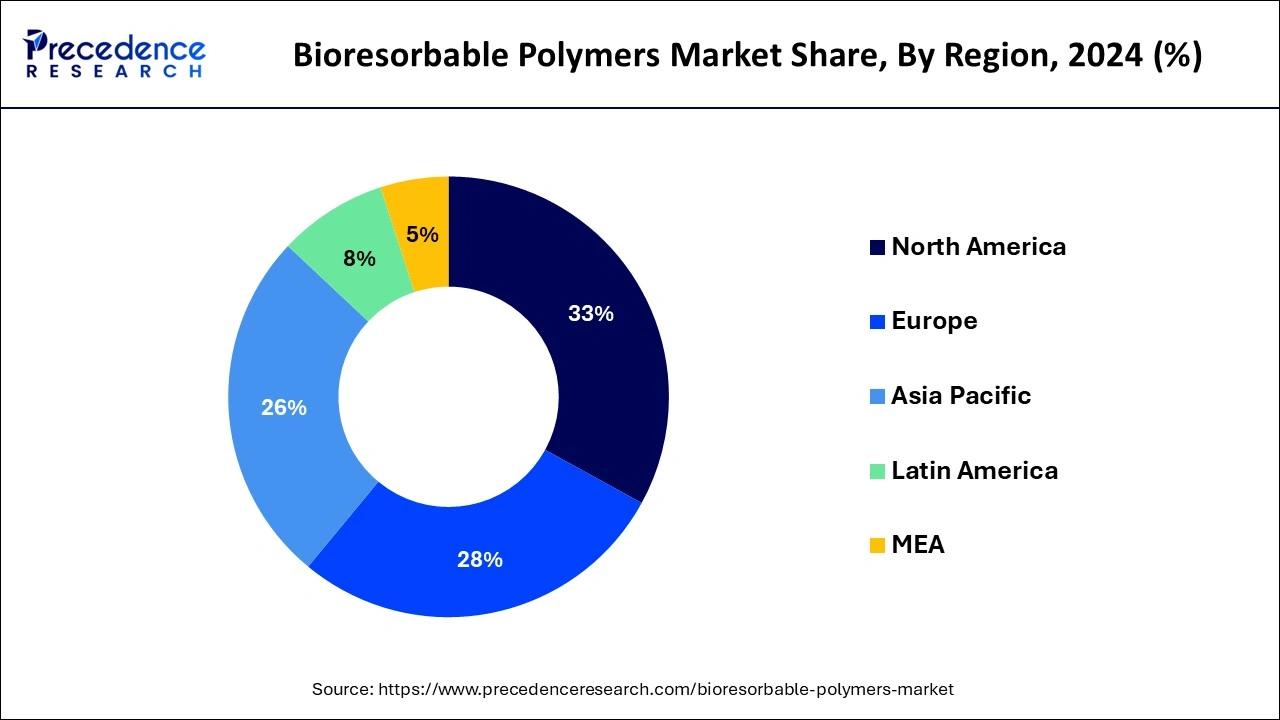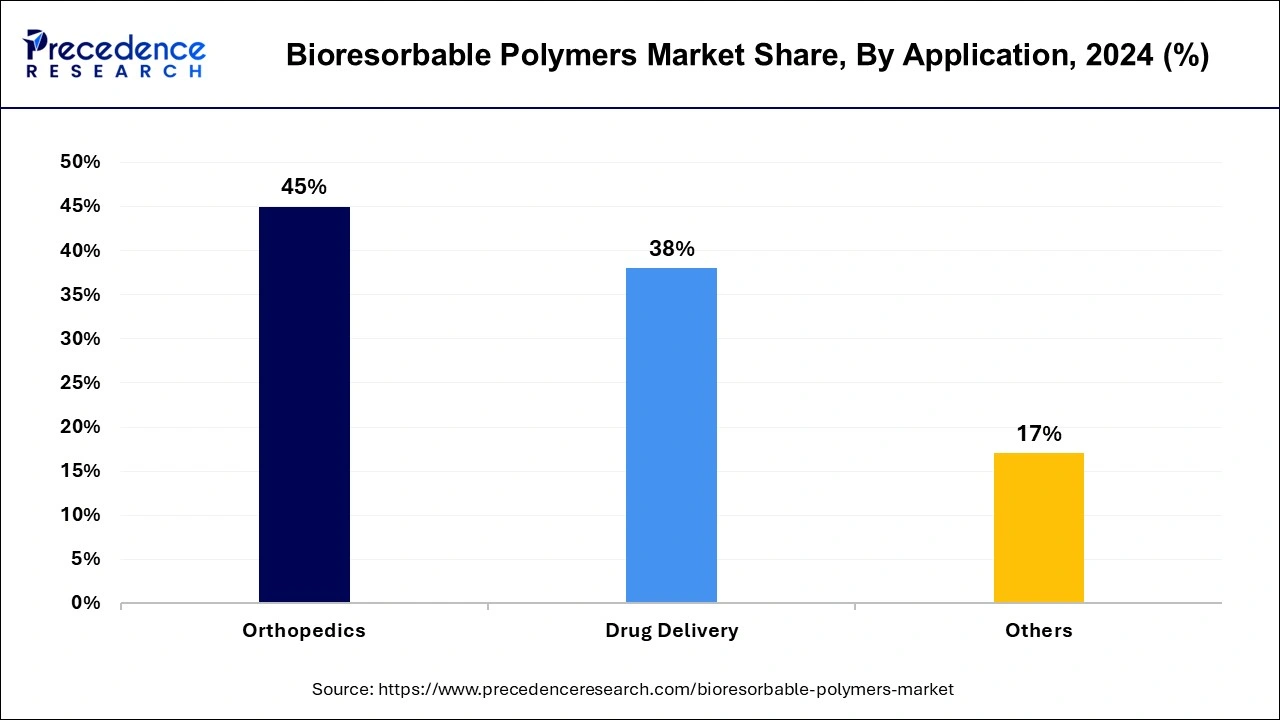August 2024
The global bioresorbable polymers market size is calculated at USD 1.97 billion in 2025 and is forecasted to reach around USD 6.17 billion by 2034, accelerating at a CAGR of 13.56% from 2025 to 2034. The North America bioresorbable polymers market size surpassed USD 570 million in 2024 and is expanding at a CAGR of 13.60% during the forecast period. The market sizing and forecasts are revenue-based (USD Million/Billion), with 2024 as the base year.
The global bioresorbable polymers market size was estimated at USD 1.73 billion in 2024 and is predicted to increase from USD 1.97 billion in 2025 to approximately USD 6.17 billion by 2034, expanding at a CAGR of 13.56% from 2025 to 2034. When utilized in medical applications, such as implants or medication delivery systems, bioresorbable polymers lower the possibility of immunological responses or unpleasant reactions because they are compatible with biological systems.

The U.S. bioresorbable polymers market size was estimated at USD 430 million in 2024 and is predicted to be worth around USD 1,550 million by 2034, at a CAGR of 13.68% from 2025 to 2034.

North America held the largest share of the bioresorbable polymers market in 2024. Due to the rising demand for bioresorbable polymers in a variety of applications, including packaging materials, drug delivery systems, and medical devices, the market for these polymers has been expanding rapidly in North America. These polymers can be used for a variety of purposes because of their benefits, which include biocompatibility, biodegradability, and flexibility. Innovative medical devices with improved biocompatibility and a lower risk of consequences are in greater demand due to the aging population and the rise in chronic diseases. The bioresorbable polymers market is expanding as a result of ongoing R&D efforts to create sophisticated, improved-property bioresorbable polymers. A growing number of people are interested in bioresorbable polymers as sustainable alternatives to conventional plastics due to rising environmental awareness and worries about plastic pollution.

Asia Pacific is emerging as the fastest-growing region in the global bioresorbable polymers market. The region's market has grown significantly in recent years due to a number of factors, including rising healthcare costs, growing public awareness of sustainable and biodegradable materials, and expanding demand for cutting-edge medical technologies. Key participants in this market include China, Japan, India, and South Korea because of their sizable patient populations and strong healthcare infrastructures. Further driving up demand for bioresorbable polymers used in implants and medical equipment is the region's recent boom in medical tourism. The need for bioresorbable polymers is growing in the area due to the rising incidence of chronic illnesses and technological developments in medicine.
The bioresorbable polymers market is primarily driven by their wide applicability in medical settings, including tissue engineering, orthopedic implants, drug delivery systems, and sutures. These polymers are very attractive in the medical field since they can break down within the body into non-toxic metabolites, removing the need for removal operations. Bioresorbable polymers are finding more and more uses in eco-friendly packaging solutions outside of the medical field.
Advanced bioresorbable polymers with enhanced qualities like mechanical strength, degradation rate control, and medication compatibility have been developed as a result of ongoing research and development activities. The bioresorbable polymers market is anticipated to keep growing due to technological developments, an increase in applications, and growing consumer awareness of environmental sustainability. The market for biodegradable and compostable packaging materials is expanding as a result of legislation designed to reduce plastic waste and growing environmental concerns.
Despite promising development potential, obstacles, including elevated production costs and restricted scalability of production processes, persist. Ongoing initiatives to address these issues, together with rising R&D spending, offer market participants extremely profitable prospects. The bioresorbable polymers market is expanding significantly worldwide, but it is primarily growing in North America and Europe because of their developed healthcare systems, robust research programs, and supportive policies that encourage the use of biodegradable materials.
| Report Coverage | Details |
| Growth Rate from 2025 to 2034 | CAGR of 13.56% |
| Market Size in 2025 | USD 1.97 Billion |
| Market Size by 2034 | USD 6.17 Billion |
| Largest Market | North America |
| Base Year | 2024 |
| Forecast Period | 2025 to 2034 |
| Segments Covered | By Product, and By Application |
| Regions Covered | North America, Europe, Asia-Pacific, Latin America, and Middle East & Africa |
Research and development
Within the larger subject of biomaterials science, bioresorbable polymer research and development is a fascinating area. These polymers—also referred to as bioabsorbable or biodegradable polymers—have attracted a lot of interest because of their potential uses in a variety of industries, such as tissue engineering, regenerative medicine, drug delivery systems, and medical devices. In order to enhance a bioresorbable polymer's mechanical strength, degradation kinetics, and biocompatibility, researchers are always creating new ones or changing ones that already exist. Bioresorbable polymers are being functionalized to give them certain qualities or functions, like controlled medication release, cell adhesion, or antibacterial action. As the bioresorbable polymers market grows, so does the need to meet regulatory criteria and guarantee the efficacy and safety of the products.
Degradation rate variability
One factor that significantly affects the bioresorbable polymers market in a variety of industries, including packaging, medicine, and pharmaceuticals, is the market's variability in degradation rates. Biodegradable or bioresorbable polymers are substances that, when broken down over time, produce harmless byproducts that the body can either absorb or eliminate. The rate at which bioresorbable polymers degrade can be affected by the processing techniques employed to create those products. The polymer's crystallinity, shape, and degradation kinetics can all be impacted by processing variables like temperature, pressure, and solvent choice. While stabilizers and antioxidants can prolong the polymer's shelf life or slow down breakdown, fillers, and reinforcing agents can change the kinetics of degradation by altering the migration of enzymes and water molecules into the polymer matrix.
Tissue engineering and regenerative medicine
The goal of the exciting fields of tissue engineering and regenerative medicine is to replace damaged human organs and tissues with functioning ones. In these domains, the bioresorbable polymers market is important because it offers matrices or scaffolds for the development of cells and tissues. Because of the way these polymers break down over time, the scaffold will eventually be replaced by freshly created tissue. Global population aging is predicted to increase demand for regenerative medicine and tissue replacements, which will propel the market for bioresorbable polymers in tissue engineering. The exact creation of complex tissue scaffolds utilizing bioresorbable polymers has been made possible by developments in 3D printing, microfabrication, and biomaterial processing. This has expanded the use of these scaffolds in regenerative medicine.
The polylactic acid segment held the largest share of the bioresorbable polymers market in 2024 and is expected to maintain its dominance during the forecast period. In fact, a big contender in the market for bioresorbable polymers is polylactic acid (PLA). It is a biodegradable polyester made from sugarcane or corn starch, two renewable resources. PLA has drawn interest because of its mechanical strength, thermal stability, and biocompatibility, which make it ideal for a range of uses in the packaging, textile, and medical sectors. PLA is frequently utilized in the medical industry for scaffolds for tissue engineering, orthopedic implants, medication delivery systems, and sutures. Because it lowers the risk of infection and does away with the necessity for removal operations, its biodegradability and compatibility with the human body make it an appealing option for these kinds of applications.
The polyglycolic acid segment is expected to grow rapidly during the forecast period. In fact, PGA is a major player in the market for bioresorbable polymers. Bioresorbable polymers, also called biodegradable polymers, are substances that, after serving their original purpose, break down within the body into non-toxic byproducts, obviating the need for surgical removal. Because of its mechanical strength, biocompatibility, and capacity to break down into non-toxic components like glycolic acid, PGA is especially important. Applications for PGA include scaffolds for tissue engineering, medication delivery devices, and surgical sutures. Its mechanical strength is retained during the crucial healing phase, after which it breaks down spontaneously and leaves no trace. This is why it is so popular. Because of this feature, PGA is a desirable choice for a range of medical applications where momentary support is required.
The orthopedics segment held the dominant share of the bioresorbable polymers market in 2024. The development of bioresorbable polymers in the orthopedics field has resulted in notable breakthroughs in recent years. These polymers' biodegradability and body compatibility make them a possible substitute for conventional materials used in orthopedic implants, such as metals. Because bioresorbable polymers break down naturally over time in the body, they can be removed surgically once the healing process is over. This characteristic lowers the possibility of persistent implant-related problems in the long run. Compared to metals, bioresorbable polymers provide more design and production freedom. This makes it possible to create implants that are specifically suited to the anatomy and requirements of each patient.

The drug delivery segment is expected to grow at the fastest CAGR during the forecast period. Within the pharmaceutical and biomedical industries, drug delivery within bioresorbable polymers is an exciting area of research and development. Biodegradable or bioresorbable polymers are substances that break down over time into harmless byproducts that the body may process or excrete. Bioresorbable polymers can be designed to target particular human tissues or organs, reducing the likelihood of systemic side effects and increasing the medication's therapeutic effectiveness. Anti-restenosis medications are delivered directly to the site of arterial injury using drug-eluting stents composed of bioresorbable polymers, which lowers the chance of the blood artery narrowing again.
By Product
By Application
By Geography
For inquiries regarding discounts, bulk purchases, or customization requests, please contact us at sales@precedenceresearch.com
No cookie-cutter, only authentic analysis – take the 1st step to become a Precedence Research client
August 2024
January 2025
February 2025
December 2024